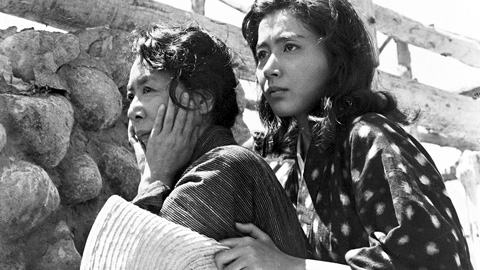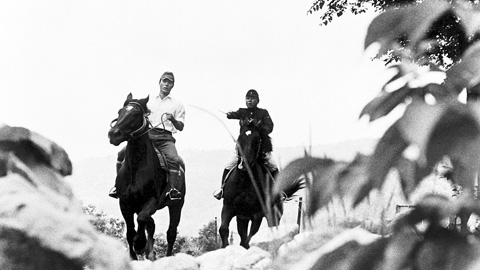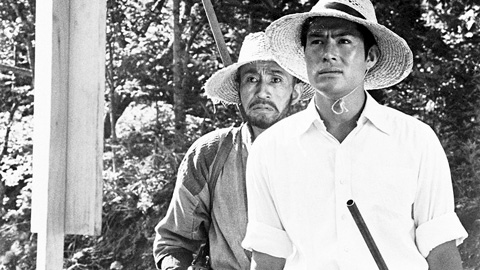A Legend or Was It?
- Year
- 1962
- Original title
- Shito no Densetsu
- Japanese title
- 死闘の伝説
- Director
- Cast
- Running time
- 83 minutes
- Published
- 14 January 2013



by Tom Mes
The Tokyo FILMeX festival’s choice to devote its 2012 retrospective slot to Keisuke Kinoshita will surely have raised an eyebrow or two. The Shochiku stalwart is an arguably rather conservative and safe choice for a festival that prides itself on unearthing some of the finest overlooked auteurs in Japanese film history and giving them a firmer place in the pantheon: Tomu Uchida, Nobuo Nakagawa, Koreyoshi Kurahara and Shinji Somai were all first-rate choices in this regard. Best known for directing the superior weepie Twenty Four Eyes and one of Japan’s first colour films, the chirpy Carmen Comes Home, Keisuke Kinoshita has on the other hand been the subject of multiple retros and DVD releases in different countries.
However, while the name and a handful of tried and true classics may be well known, the extensive Kinoshita program offered by FILMeX nevertheless yielded a number of discoveries. Not the least of these was A Legend or Was It?, a powerful tale that chronicles the most extreme consequences of rigid small-town social codes. In some ways comparable to Uchida’s The Outsiders, rediscovered at the same festival in 2004, Kinoshita’s film utilizes its setting in mountainous Hokkaido to emphasize the isolation of a rural village community during the final days of the Pacific War. Struggling with crops and sons sacrificed to the war effort, the community under de facto headman Takamori must welcome the Sonobe family, returnees from a firebombed Tokyo. The son, Hideyuki (Kato) escaped death on the battlefield after contracting an illness and being sent home, while the daughter Kieko (Iwashita) is destined to marry Takamori’s proud son Goichi (Sugawara), who was himself sent home from the Manchurian front after crippling his left arm.
Hideyuki, however, is dead set against his sister’s betrothal, having witnessed Goichi raping and killing innocents in China. When the family hears this, their collective refusal raises Goichi’s ire. The following day, their crops are discovered vandalized, setting off a chain of retributions that send the village community spiralling off into violence and death.
The film’s opening scenes of peaceful rural life are set in an idyllically verdant valley surrounded by mountain ranges as monumental as any of John Ford’s. However, these soon give way almost literally to the dark side of this pastoral image, as the film stock switches to monochrome and the story proper begins. At 83 minutes, the running time of A Legend or Was It? is anything but monumental – and so much the better. This is taut storytelling at its best. Devoid of drawn-out attempts at seeming epic, the film presents its majestic setting as an impressive but also inescapable fact of life.
While some characters do border on two-dimensional, in particular the contrast between the haughty Goichi and the reserved Hideyuki, Kinoshita presents a morality play here, with the characters serving appropriate symbolic functions. Goichi, the former army officer still parading around town on horseback and in uniform, orchestrates the ostracism of the Sonobe family like battlefield strategy, set to the incessant twang of the mouth harp on the soundtrack that suggests escalating madness and impending doom. It comes as no surprise that Goichi will end up repeating the transgressions he committed in battle. Indeed, the film’s setting and time frame unmistakably suggest a similarity between the mob violence in which the villagers lose themselves and the actions of Japan’s soldiers in China: as the village men rush to lynch the “traitors”, their wives wave them on from the roadside like mothers sending their brave husbands and sons off into battle.
At the same time, the almost pacifistic Hideyuki and the feisty figure of Yuri (Kaga), daughter of the sympathetic neighbour who proves to be much more than merely Hideyuki’s would-be love interest, seem to symbolize the Japan to come, the post-war, Article-9 Japan, whose existence seems as yet unimaginable, not to mention intolerable, in the days before the nation’s surrender.
A Legend or Was It? is a powerful, unsettling film. Fordian in its scope, Fuller-esque in its pull, Peckinpah-like in its relentlessness.